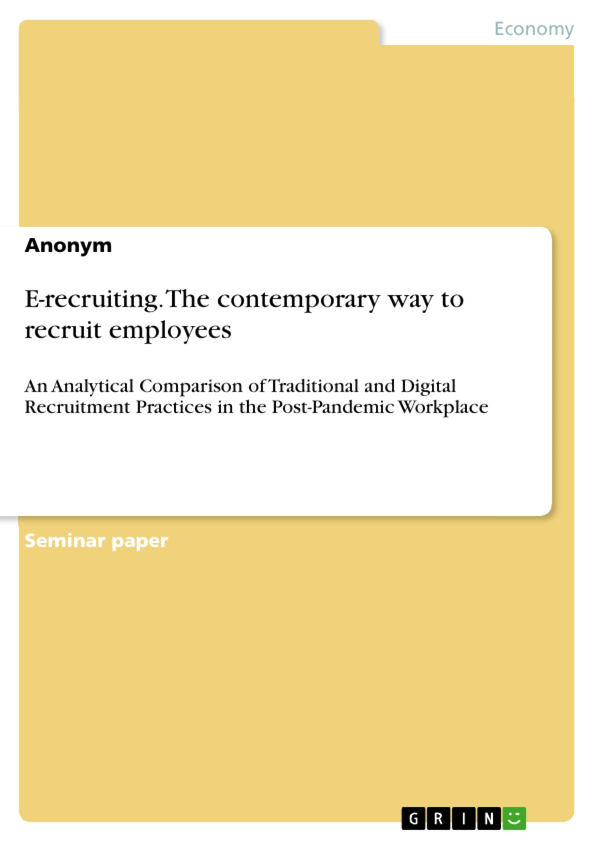This paper explores the rise of E-recruiting as a modern alternative to traditional hiring practices, especially in the context of the COVID-19 pandemic. It compares classical recruitment tools with digital methods such as online job portals, social media, and virtual interviews. The analysis shows how E-recruiting improves efficiency, reduces costs, and enhances candidate reach, while also presenting challenges such as impersonal communication and digital overload. The paper is ideal for students, HR professionals, and anyone interested in the digital transformation of human resource management and the future of recruitment.
Table of Contents
- 1. Introduction
- 2. Introduction to Recruitment
- 2.1 The classical recruitment
- 2.2 Classical instruments
- 3. "Modern" Recruitment
- 3.1 E-recruiting
- 3.2 Sustainable Recruiting
- 3.3 E-recruiting development
- 3.4 Advantages of E-recruiting
- 3.5 Disadvantages of E-recruiting
- 4. Conclusion
Objectives and Key Themes
This paper aims to compare employee recruitment methods before and after the COVID-19 pandemic, focusing on the emergence and impact of e-recruiting. It will explore the transition from traditional recruitment practices to modern digital strategies.
- The impact of the COVID-19 pandemic on recruitment practices.
- A comparison of classical and modern recruitment methods.
- The development and implementation of e-recruiting.
- The advantages and disadvantages of e-recruiting.
- The shift towards digitalization in the world of work.
Chapter Summaries
1. Introduction: This chapter sets the stage by highlighting the significant impact of the COVID-19 pandemic on the acceleration of digital transformation in the recruitment sector. It emphasizes the challenges faced by companies in adapting to remote work and contact restrictions, illustrating how the pandemic forced a rapid shift from in-person to virtual hiring processes. The chapter uses statistics to demonstrate the widespread adoption of virtual recruiting methods and predicts its lasting influence on organizational practices. It introduces the paper's focus on e-recruiting as a key element of this transformation.
2. Introduction to Recruitment: This section lays the groundwork by providing a general overview of recruitment, differentiating between classical and modern approaches. It delves into the traditional methods and tools used in personnel management, providing context for the later discussion of e-recruiting and its innovations.
3. "Modern" Recruitment: This chapter focuses on contemporary recruitment strategies, specifically examining e-recruiting, its evolution, and its associated benefits and drawbacks. It explores the concept of sustainable recruiting within the broader context of digital transformation and analyzes how various aspects of e-recruiting have contributed to the changing landscape of talent acquisition. The discussion likely includes an in-depth examination of the advantages, such as cost savings and increased reach, and disadvantages, such as potential biases and security concerns, associated with online recruitment platforms.
Keywords
E-recruiting, digital recruitment, COVID-19, pandemic, virtual hiring, talent acquisition, classical recruitment, sustainable recruiting, online recruitment, digital transformation.
Frequently asked questions
What is the main topic of this document?
This document provides a language preview related to employee recruitment methods, focusing on the impact of the COVID-19 pandemic and the rise of e-recruiting.
What is included in this language preview?
The preview includes the title, table of contents, objectives and key themes, chapter summaries, and a list of keywords.
What are the objectives of the research outlined in this preview?
The research aims to compare employee recruitment methods before and after the COVID-19 pandemic, emphasizing the emergence and effects of e-recruiting. It also aims to explore the transition from traditional to digital strategies.
What are the key themes covered in this document?
Key themes include the impact of the COVID-19 pandemic on recruitment, a comparison of classical and modern recruitment methods, the development and implementation of e-recruiting, its advantages and disadvantages, and the shift towards digitalization in the world of work.
What is the focus of Chapter 1 (Introduction)?
Chapter 1 highlights the significant impact of the COVID-19 pandemic on accelerating digital transformation in the recruitment sector and the challenges companies faced in adapting to remote work.
What is the focus of Chapter 2 (Introduction to Recruitment)?
Chapter 2 provides a general overview of recruitment, differentiating between classical and modern approaches, and discussing traditional methods and tools.
What is the focus of Chapter 3 ("Modern" Recruitment)?
Chapter 3 focuses on contemporary recruitment strategies, specifically e-recruiting, its evolution, benefits, and drawbacks. It also explores sustainable recruiting within the context of digital transformation.
What are some of the keywords associated with this document?
Keywords include E-recruiting, digital recruitment, COVID-19, pandemic, virtual hiring, talent acquisition, classical recruitment, sustainable recruiting, online recruitment, and digital transformation.
What are some of the advantages of e-recruiting mentioned?
The document mentions potential cost savings and increased reach as advantages of e-recruiting.
What are some of the disadvantages of e-recruiting mentioned?
The document mentions potential biases and security concerns as disadvantages of e-recruiting.
- Quote paper
- Anonym (Author), 2022, E-recruiting. The contemporary way to recruit employees, Munich, GRIN Verlag, https://www.grin.com/document/1596438



